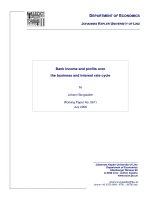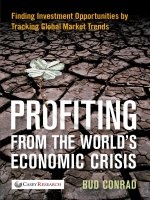Crocker basic income and sovereign money the alternative to economic crisis and austerity policy (2020)
Bạn đang xem bản rút gọn của tài liệu. Xem và tải ngay bản đầy đủ của tài liệu tại đây (2.11 MB, 105 trang )
Basic Income and
Sovereign Money
The Alternative
to Economic Crisis
and Austerity Policy
Geoff Crocker
Basic Income and Sovereign Money
Geoff Crocker
Basic Income
and Sovereign Money
The Alternative to Economic Crisis and Austerity
Policy
Geoff Crocker
Basic Income Forum
Bristol, UK
ISBN 978-3-030-36747-3
ISBN 978-3-030-36748-0 (eBook)
/>© The Editor(s) (if applicable) and The Author(s), under exclusive license to Springer
Nature Switzerland AG 2020
This work is subject to copyright. All rights are solely and exclusively licensed by the
Publisher, whether the whole or part of the material is concerned, specifically the rights
of translation, reprinting, reuse of illustrations, recitation, broadcasting, reproduction on
microfilms or in any other physical way, and transmission or information storage and
retrieval, electronic adaptation, computer software, or by similar or dissimilar methodology
now known or hereafter developed.
The use of general descriptive names, registered names, trademarks, service marks, etc.
in this publication does not imply, even in the absence of a specific statement, that such
names are exempt from the relevant protective laws and regulations and therefore free for
general use.
The publisher, the authors and the editors are safe to assume that the advice and information in this book are believed to be true and accurate at the date of publication. Neither
the publisher nor the authors or the editors give a warranty, expressed or implied, with
respect to the material contained herein or for any errors or omissions that may have been
made. The publisher remains neutral with regard to jurisdictional claims in published maps
and institutional affiliations.
Cover illustration: © Melisa Hasan
This Palgrave Pivot imprint is published by the registered company Springer Nature
Switzerland AG
The registered company address is: Gewerbestrasse 11, 6330 Cham, Switzerland
I dedicate this book with huge thanks to Dick Morley and John Hey whose
lectures and tutorials inspired me to think fundamentally and radically
about economic theory.
Contents
Part I
The Proposal as Policy
3
4
6
7
1
Summary and Core Argument
The Main Issue
The Main Claim
The Core Argument
2
Economic Events, Policies, and Crisis
The Timeline of Economic Events and Policies
Diagnosing the Crisis
Correcting the Crisis
Tighter Financial Regulation
Quantitative Easing
Austerity Policy
11
11
14
16
16
18
19
3
An Alternative Radical Diagnostic
The Nature of Income
The Nature of Money
Sovereign Money
Summarising Sovereign Money
A Radical Synthesis
A Thought Experiment
A New Policy Paradigm
23
25
29
35
39
42
43
45
vii
viii
4
CONTENTS
Scoping the Funding of Basic Income
Increasing Tax and Reducing Means-Tested Welfare Benefits
Raising New Taxes
Another Alternative—Universal Basic Services (UBS)
47
49
50
51
Wider Arguments for Basic Income and Sovereign Money
+4 Other Great Reasons for Basic Income
Human Flourishing
Work
Environmental Responsibility
Social Justice
Welfare System Efficiency
+3 Other Great Reasons for Sovereign Money
Basic Income and Sovereign Money Policy—The Corrective for
Economic Crisis and Austerity Policy
Implementing the Policy Proposal
Pilot Basic Income Projects
A Phased Implementation Pathway with Iterative
Monitoring
53
53
54
56
59
60
61
61
62
63
63
65
Part II The Context of the Proposal in Contemporary
Economic Thought
5
6
Diagnosing the 2007 Economic Crisis
Adair Turner ‘Between Debt and the Devil’ (2016)
Martin Wolf ‘The Shifts and the Shocks’ (2014)
Robert Skidelsky ‘Money and Government’ (2018)
Robert Skidelsky and Nicolò Fraccaroli (Ed.) ‘Austerity vs
Stimulus’ (2017)
Mark Blyth ‘Austerity: The History of a Dangerous Idea’
(2013)
Basic Income and Sovereign Money Within a Brief History
of Economic Thought
Keynes and the 1930s Great Depression
The 2007 Economic Crisis
69
69
71
73
75
77
81
82
83
CONTENTS
7
Basic Income and Sovereign Money: The Current
Literature
Joseph Huber ‘Sovereign Money’ (2017)
Conclusion
Bibliography
ix
89
92
94
97
List of Figures
Fig. 2.1
Fig. 2.2
Fig. 3.1
Fig. 3.2
Timeline of UK economic events and policies
Bank of England banking sector capital/asset ratios 2014–2018
(Source Bank of England www.bankofengland.co.uk/statist
ics/banking-sector-regulatory-capital/2018/2018-q3, www.
bankofengland.co.uk/-/media/boe/files/statistics/banking
-sector-regulatory-capital/2018/2018-q3.pdf?la=en&hash=
43FD266E0E42D434A0B5DDA4736698E0BF886440)
UK labour income and consumer spend 1948–2016 (Note
That ONS define ‘Labour income’ = wages + self-employed
income. I am grateful to David Matthewson and other staff at
the Office for National Statistics for valuable help in defining
and interpreting UK income data streams. Source Graph
constructed by the author from Office for National Statistics
data. UK Second Estimate of Data Tables, Charlotte Richards,
p. A13, series YBEU www.ons.gov.uk/economy/grossdomesti
cproductgdp/datasets/uksecondestimateofgdpdatatables)
Shares of unearned income UK economy 1997–2016 (Source
Graph constructed by the author from Office for National
Statistics data www.ons.gov.uk/peoplepopulationandcommuni
ty/personalandhouseholdfinances/pensionssavingsandinvestme
nts/adhocs/005424timeseriesofukhouseholdincomeestimatesf
orprivatepensionsandinvestmentincomefrom1977to201415byh
ouseholdtype)
12
17
25
26
xi
xii
LIST OF FIGURES
Fig. 3.3
Fig. 3.4
Fig. 3.5
Fig. 3.6
Fig. 3.7
Fig. 3.8
Fig. 3.9
Fig. 3.10
UK GDP, disposable income, household loans 1987–2017
(Source Graph constructed by the author from Office for
National Statistics data www.ons.gov.uk/economy/grossdome
sticproductgdp/timeseries/habn/ukea?referrer=search&search
Term=habn)
UK GDP/disposable income gap vs household loans
1987–2017 (Source Graph constructed by the author from
Office for National Statistics data www.ons.gov.uk/economy/
grossdomesticproductgdp/timeseries/habn/ukea?referrer=sear
ch&searchTerm=habn)
UK Household debt and gross disposable income 1997–2018
(Source Graph constructed by the author from Office for
National Statistics data)
UK deficit as percentage GDP 1994–2017 (Source Graph
constructed by the author from Office for National Statistics
data. UK government debt and deficit, Ana Oliveira Figure 1:
General government gross debt as a percentage of gross
domestic product www.ons.gov.uk/economy/governmentpub
licsectorandtaxes/publicspending/bulletins/ukgovernmentdeb
tanddeficitforeurostatmaast)
UK debt as percentage GDP 1994–2017 (Source Graph
constructed by the author from Office for National Statistics
data. UK government debt and deficit, Ana Oliveira Figure 1:
General government gross debt as a percentage of gross
domestic product www.ons.gov.uk/economy/governmentpub
licsectorandtaxes/publicspending/bulletins/ukgovernmentdeb
tanddeficitforeurostatmaast)
G7 economies deficit as percentage GDP 2000–2017 (Source
Graph constructed by the author from Organisation for
Economic Cooperation and Development [OECD] data.
OECD [2018], General government deficit [indicator].
d.
org/gga/general-government-deficit.htm)
World economies’ deficit as percentage GDP 2016 (Source
Graph constructed by the author from Organisation for
Economic Cooperation and Development [OECD] data.
OECD [2018], General government debt [indicator].
d.
org/gga/general-government-debt.htm)
Comparison of orthodox and heterodox theories of money
(Source Diagram constructed by the author)
27
28
28
29
31
32
33
34
LIST OF FIGURES
Fig. 3.11
Fig. 3.12
Fig. 3.13
Fig. 4.1
Fig. 4.2
Fig. 7.1
UK sectoral financial balances 1987–2017 (Source Office for
National Statistics www.ons.gov.uk/economy/nationalaccou
nts/uksectoraccounts/bulletins/quarterlysectoraccounts/janu
arytomarch2019)
Flows of money in the UK economy (Source Diagram
constructed by the author)
CBIT scheme cost (Source />tent/uploads/2018/09/Student-poster-2018-final.pdf)
Weekly working hours 1870–2000 (Source Our World in Data
‘charts and data can be freely downloaded and embedded in
others’ work’, />A summary of the benefits of a policy of basic income funded
by sovereign money (Source Diagram constructed by the
author)
The radical triangle (Source Diagram constructed by the
author)
xiii
37
40
49
55
63
91
PART I
The Proposal as Policy
CHAPTER 1
Summary and Core Argument
Abstract A radical claim is developed that in combination, basic income
and sovereign money uniquely counteract economic crisis and austerity
policy. Modern high technology economies are dysfunctional, delivering not only crisis and austerity, but also pervasive debt, poverty, low
pay, inequality, and ecological damage. As earned income declines against
output, unearned income becomes an essential component of aggregate
demand. Basic income is the best form of unearned income.
Keywords Basic income · Sovereign money · Economic crisis · Austerity
policy · Debt · Inequality
Summary
This book presents a radical economic diagnostic and policy proposal.
The claim is that a combination of basic income and sovereign
money creation will uniquely counteract economic crisis, reverse
austerity policy, reduce debt in the economy, and offer environmental gains.
Historic economic data is analysed to demonstrate that disposable consumer income declines in relationship to both consumer
© The Author(s) 2020
G. Crocker, Basic Income and Sovereign Money,
/>
3
4
G. CROCKER
expenditure and economic output. The role of unearned income
therefore increases over time. Unearned income comprises welfare
benefits, pensions, dividends, and household debt. Household debt
quickly grows and becomes unrepayable from the same diminished
real earnings, leading to economic crisis as in 2007. Meanwhile,
financial orthodoxy insists that deficit government expenditure and
money issue must be balanced by new government debt. This debt
accumulates to a level above annual GDP, and so also becomes unrepayable. Governments respond with austerity policy to reduce deficit
and debt accumulation.
Basic income supplements declining real incomes, and displaces
household debt. Debt-free sovereign money funds basic income,
removes the deficit constraint on public expenditure, and reverses
austerity policy. By cutting the link between economic well-being,
employment and output, ecological outcomes are improved.
The hypothesis behind the diagnostic and proposal is that high
productivity technology causes the divergence between output and
earnings which requires basic income, but at the same time makes
basic income affordable against the real criterion of available economic output. Similarly, as technology causes real earnings to fall
compared to output, then debt-free sovereign money is required
and justified to supplement consumer income, and sustain public expenditure. This hypothesis is the subject of a 3-year research
project at the Institute for Policy Research at the University of Bath,
UK.
The book’s analysis focusses on data from the UK economy for
ease of consistent presentation, and as a specific test case of a more
general economic hypothesis.
The Main Issue
The post-war model of economic management is in crisis and needs
urgent adjustment. The free market mixture of private investment, production and consumption, combined with government expenditure and
fiscal and monetary policy, has worked reasonably well. It has delivered a
general increased standard of living, and relatively stable economies.
1
SUMMARY AND CORE ARGUMENT
5
This relative success owes much to technology. In earlier agrarian
economies, and in initial industrial economies, productivity was low,
and output insufficient to provide an adequate standard of living. Need
exceeded supply, poverty was widespread, people were ill-clothed and illfed, partly because as Keynes showed, need was not translated into effective demand via adequate wages, but also because output was limited by
low productivity technology. Major advances in technology throughout
the twentieth century mean that productivity rose astronomically, such
that potential output in the ‘machine age’ is adequate, and it is now
effective demand which is not fully funded. This in turn feeds back to
impose a limit on productive output. This then threatens employment,
and since employment is the main means of income, standards of living
are compromised.
But we now face partial system failure, generating seriously dysfunctional outcomes of
•
•
•
•
•
•
•
economic crisis, actual or likely to repeat
pervasive debt, both household and government
continuous austerity policy
extensive poverty
low pay jobs
increased inequality
ecological damage.
This needs a radical re-think and economic system re-engineering. There
are many calls for new thinking in economics. Many think tanks address
this aim, for example, the Institute for New Economic Thinking, the
New Economics Foundation, the Institute for Public Policy Research,
the Resolution Foundation, and the Progressive Economy Forum. The
Association of Heterodox Economists meets annually, and Reteaching
Economics seeks to redefine economic philosophy and education. This
book brings together two such new ideas, for basic income and sovereign
money, which offer a radical alternative paradigm to contemporary economic thinking. The combined proposal counteracts crisis and austerity,
and offers ecological advantage, but lies within the established thinking
of Keynesian economics that aggregate demand is the key policy target
and tool in modern economic analysis and policy formulation.
6
G. CROCKER
The Main Claim
This book makes a big claim, that a combination of basic income and
sovereign money can avoid economic crisis and austerity policy.
There are already many proposals for basic income, and separately for
sovereign money. Basic income is the proposal that all citizens receive an
unconditional income. Its advocates see it as a means to correct the social
injustice of inequality, to give economic security to a ‘precariat’ group
in society, to enable economic initiative, and to replace the expensive,
intrusive nature of current welfare benefit systems. Critics claim that this
would represent a disincentive to work, but advocates respond that on the
contrary, it is current welfare benefit systems which are a disincentive to
work, since any earned income will be deducted from benefit payments,
whereas basic income is still received when someone takes work.
Sovereign money proposals come in several forms, but essentially
expect governments to issue money directly to maximise economic activity and engagement. Some advocates specify that such government issued
money should be matched by debt, for example in the sale of government
bonds, whilst others advocate that it should be debt free. The current
leading rationales for sovereign money are (i) to limit the excess issue of
money by commercial banks into finance-only markets, which is thought
to have caused the 2007 economic crisis and (ii) to fund job guarantee
programs to ensure full employment and therefore well-being.
However, both basic income and sovereign money proposals have a
further crucial impact, namely that each can be defined with the intention
of reducing debt in the economy. As an initial over-simplification, basic
income can avoid the need for households to increase their borrowing to
fund their expenditure, and hence radically reduce consumer debt. Since
the massive rise in consumer debt was a main factor in generating the
2007 economic crisis, then replacing consumer debt with basic income
will avoid such crisis.
Equally, if governments issued direct sovereign money and defined
this to be debt-free, i.e. issued without the matching sale of government
bonds, then the government expenditure this sovereign money funded
would no longer be defined as deficit spending, and public sector debt
would not be incurred. Austerity policy would then not be necessary
to reduce otherwise escalating government deficit, mounting up as debt
almost equal to, or in some cases well above, the entire annual GDP of the
economy. Both of these points will be developed more fully throughout
the rest of this book.
1
SUMMARY AND CORE ARGUMENT
7
A combination of basic income funded by sovereign money therefore
reduces consumer and government debt respectively, and so avoids crisis and austerity. It’s crucially important to state at this point that such
issue of sovereign money, and payment of basic income, must be constrained by the estimate of potential full employment output GDP. Otherwise the policies would be inflationary. But up to the level of potential
full output GDP, basic income and sovereign money would enable austerity cuts to be reversed, real productive investment to be increased, and
standards of living for lower income groups to be raised. Basic income
is a proposal addressed to individuals, but sovereign money can also be
issued to government spending departments, including to local government administrations whose recent severe budget cuts have inflicted social
and economic pain on their local population.
Combining proposals for basic income and sovereign money is an
example of synergy where the whole exceeds the sum of the parts. Whilst
each of basic income and sovereign money have independent justifying
rationale, their combined impact in averting crisis and austerity lends
immense weight to their policy proposal.
The Core Argument
The core argument presented in this book is
In high technology economies, productivity means that the wage component of output reduces.
Earned income becomes insufficient to purchase the productive output of the economy, or to meet consumers’ expenditure.
This requires increased unearned income in the form of pensions,
welfare benefits, dividends, and consumer credit.
Increased welfare benefits push government spending into deficit,
and increase national debt to levels which can never be repaid.
Increased consumer credit leads to unsustainable household debt
which cannot be repaid out of the same declining wage share.
This leads to default, the meltdown of a financial sector built on this
debt, and economic crisis.
Governments follow this by austerity policy, mistakenly trying to
reduce the deficit, but thereby increasing poverty and inequality.
8
G. CROCKER
Technology will inevitably increase productivity, measured in real
unpriced units of output per hour worked. This remains true even after
taking account of the resources used in developing and implementing the
technology itself. Technology changes the combination of capital equipment and labour in the production of goods and services. It requires
investment in capital equipment, and changes in working practices. Economic theory seeks to explain the relative use of capital and labour according to their factor prices. Higher wages are said to favour a shift to investment in labour saving capital equipment, thus reducing employment and
increasing output per employee. However, usually the capital equipment
not only reduces labour employment, but also substantially increases output, so that the productivity effect can be huge, dividing increased output
by decreased labour. This means that capital/labour substitution is not
simply generated by shifts in factor prices of capital and labour, but by
those factor prices set against increased output. Technology investment
can also be a ‘game changer’, i.e. a proactive visionary phenomenon with
systemic quantum leap effects, rather than a reactive fine-tuning response
to changes in factor prices. The results can be dramatic, as some examples
included later in this book demonstrate. The increase in productivity can
be, and historically has been, so immense, that production exceeds what
the labour force itself can consume. Wages cannot therefore increase as
rapidly as output, meaning that the wage content of output must reduce.
There are other factors at work which also reduce the wage content
of output, or the wage share of GDP. In a market economy, wages result
from bargaining power. Many commentators consider that the reduction
of trade union bargaining power has led to wages being depressed compared to profit. This would also contribute to the decline in the wage
share of output which has been demonstrated in several academic studies,
and which will be shown to be the case from data analysed later in this
book. The two factors of technological productivity and labour bargaining power are mutually reinforcing, since the reduced demand for labour
in advanced technology production itself reduces the bargaining power
of labour. What in fact emerges is a very bifurcated labour market where
a small high skill elite commands ever higher remuneration, alongside a
large lower skill group suffering depressed wages and in-work poverty.
The combination of these two opposite factors adds up to an aggregate
outcome where total wages in the economy decline as a proportion of
output. This will be conclusively demonstrated in the data analysis which
follows below. The point is also often also made by expressing the issue
1
SUMMARY AND CORE ARGUMENT
9
in terms of inequality, which as Thomas Piketty and others have demonstrated, has grown immensely in modern economies, not only in terms
of inequality of income, but even more so in inequality in wealth. There
is extensive debate between academic economists as to how the various
measures of the wage share of output and income inequality interact, but
these result in a common agreement that aggregate demand in the economy becomes deficient.
Specifically, we will see from UK data that total earned income has
declined against consumer expenditure consistently over the long 70-year
time period from 1948 to 2016. Wages have declined as a proportion of
both output and expenditure, to the point that in aggregate we no longer
earn enough to fund our consumption.
This leads to an unavoidable requirement to supplement earned
income with unearned income, which, as we show below, has indeed
grown substantially in the form of pensions, welfare benefits, dividends,
and household borrowing. Within unearned income, the share of dividends has grown, whilst the share of welfare benefits has declined, which
immediately suggests mounting inequality. But it is the role of household
borrowing which is of great concern, since it led, and is leading again, to
unsustainable levels of indebtedness. Meanwhile, the increase in welfare
benefits has pushed government budgets into continued deficit, which has
led to huge government indebtedness. The economic system is inherently
and recurrently generating household and government debt which have
led to bank failure, economic crisis, and forced governments into austerity
policies, which have reduced economic support for low income groups in
society.
At the same time, current financial orthodoxy insists that governments
balance their budgets, at least in the long term. Given the technologygenerated increased need for unearned income to sustain aggregate
demand in the form of welfare benefits, government budgets are pushed
into deficit. Financial orthodoxy then kicks in, and insists on deficit reduction. Hence austerity policy which reduces benefits to low income groups,
and thereby further reduces aggregate demand. Low income groups are
pushed into further borrowing and debt and the perverse economic circle
is reinforced.
The surprising but sustainable claim of this argument is that these negative outcomes are at least in part due to technology as it works through
the current economic system. Since the high productivity enabled by technology is a source of huge potential economic benefit, then it requires us
10
G. CROCKER
to radically re-engineer the economic system to derive maximum human
and environmental benefits from technology, and not to suffer adverse
consequences from a perversely designed economic system which translates increased productivity into suppressed aggregate wage, deficient
aggregate demand, economic crisis, government deficit constraints, the
poverty of austerity, and environmental damage.
The only solution to this is a basic income paid to everyone,
to avoid household debt, and to fund this by sovereign money
issued by government, without requiring the purchase of government bonds or the initial issue of those same government bonds,
thus avoiding government debt and the austerity policy imposed by
deficit reduction.
If we are able to replace some part of household borrowing with basic
income, then households would not bear unsustainable debt. This would
not then lead to economic crisis like the 2007 crisis, which began with
sub-prime US mortgage debt. Equally, if we could replace some part of
government deficit with sovereign money, i.e. debt-free money issued
directly to fund basic income, as well as central and local government
expenditure, then government expenditure would be constrained by real
output GDP and not by artificial deficit spending constraints.
This may read like a dreamland proposal, but the rest of this book
works through the arguments which support it as the only real viable
alternative to the endemic debt, crisis, and austerity policy of the present
economic system.
CHAPTER 2
Economic Events, Policies, and Crisis
Abstract Post-war economic policy is traced through Keynesian demand
management and two variants of monetarism. The standard behavioural
explanation of the 2007 economic crisis in terms of bad banks and
poor government regulation is challenged by a more structural explanation focussing on inadequate aggregate demand supplemented by a huge
growth in consumer debt. Post-crisis policies of tighter financial regulation, quantitative easing, and austerity policy are analysed and critiqued.
QE raised asset prices, increased inequality, but failed to stimulate the
economy. Austerity policy has caused huge unnecessary social harm.
Keywords Keynesian · Monetarism · Consumer debt · Quantitative
easing · Austerity
The Timeline of Economic Events and Policies
In order to develop relevant and effective policies to combat economic
crisis and austerity policy, we need to understand the narrative of events
leading to the crisis, and then identify the fundamental variables generating this narrative. The economic events and government policy responses
in the UK economy up to, during, and following the crisis are, Fig. 2.1.
The Great Depression of the 1930s led to worldwide GDP falling
by 15% in its first three years of 1929–1932. During the same period,
© The Author(s) 2020
G. Crocker, Basic Income and Sovereign Money,
/>
11
12
G. CROCKER
Year
Event / outcome
Policy
1948–2016
Earned income becomes insufficient to purchase GDP
Keynesian fiscal
demand management
Unearned income increases to compensate,
including consumer credit / household loans
Monetarism 1
Quan ty of money control
Monetarism 2
Interest rate control of infla on
2004
Household loans peak at £165bn, leading to crisis
2007
** CRISIS **
from 2008
Household loans fall to £4bn
Tighter bank regula ons
Welfare benefit incomes fall
Austerity
Asset prices increase
Quan ta ve Easing QE
by 2017
Household loans increase to £77bn
Inequality increases
Poverty increases
When?
** NEXT CRISIS ?? **
Fig. 2.1 Timeline of UK economic events and policies
industrial production fell by over 40% in Germany and the USA, and
by nearly 25% in the UK and France, causing unemployment which rose
to 25% in the USA, and widespread poverty. The American economist
Spurgeon Bell, in his Productivity, Wages and National Income showed
how productivity had led to aggregate demand deficiency. Keynes claimed
that insufficient effective aggregate demand was a main causal factor of
the depression, and set out his analysis and policy remedy in his 1936
seminal General Theory of Employment, Interest, and Money. Franklin D.
Roosevelt implemented Keynesian policies in the government investment
programme of his ‘New Deal’. Keynes’s proposals for demand management were then rendered urgently necessary in the rearmament leading
to the Second World War, and remained in place throughout it. Economic historians debate whether it was Keynesian economic thought, or
the enforced economic event of rearmament, which led to the implementation of demand management, but they certainly dovetailed to ensure
2
ECONOMIC EVENTS, POLICIES, AND CRISIS
13
that this remained a core principle of fiscal economic management in the
post war period.
The management of government expenditure and investment, private
sector investment, and consumer expenditure, which with the addition of
the external trade surplus or reduction by a trade deficit, add to national
GDP, became deeply embedded in the core of economic policy and management. This resolved relatively well for some 25 years until the shock
to the world economy of the OPEC increases in oil prices of 1973. The
Arab oil producers in OPEC imposed an embargo on exports to countries
they deemed to have supported Israel during the Yom Kippur war. This
led to an increase in the oil price from $3 to $12/barrel. The resulting
exogenous shock inflation in western economies led to ‘stagflation’, i.e.
a combination of high inflation and economic decline. This was wrongly
thought by some commentators to discredit the long-established Keynesian paradigm of economic policy by fiscal demand management, and
opened the field to alternative monetary theories of economic management.
Championed by Milton Friedman and Anna Schwartz in their A Monetary History of the United States, 1867 –1960, the alternative theory of
monetarism claimed that governments should manage the economy by
managing the quantity of money in the economy, rather than using taxation and government expenditure programs to manage aggregate demand
within fiscal policy. However, it soon became apparent that management
of the money supply faced several difficulties, since banks create money
when they lend to customers based on sound business plans or fundable
repayment schedules, and since consumers were increasingly able to create
money directly by increasing their expenditure on the ‘plastic money’ of
credit cards. Having failed to control the aggregate money supply directly,
monetarists then sought as an alternative to control it indirectly through
its price, i.e. the interest rate. Whilst fiscal policy continued because governments certainly included aggregate demand of government expenditure and investment, private sector investment, and consumer expenditure
in their economic management policies, monetarist policy was added into
a combined paradigm where the interest rate and the tax rate were both
recognized as the tools of economic management, but with the interest rate predominating. Demand for money, the creation of money and
therefore the quantity of money, would all be managed by the interest
rate. Moreover, within this monetarist paradigm, inflation, rather than
employment or output, became the target of economic policy. Central
14
G. CROCKER
banks were made independent of central government, and instructed to
use the interest rate to price money so as to control inflation to a target
level, typically of 2%. This paradigm, known as the ‘Washington Consensus’ remained dominant until the economic crisis of 2007.
We will show in subsequent chapters of this book, that significant other
developments ran in parallel within this history of economic management. Primary to our diagnostic, over the long period of 1948–2016,
earned income became ever less adequate to fund consumer expenditure. In the immediate post-war period, earned income sufficed to totally
fund consumer expenditure, but in the UK, by 1995, consumer expenditure exceeded earned income, and has continued to do so ever since.
This led to an increased reliance on unearned income to meet consumer
expenditure needs, including pensions, welfare benefits, and dividends,
but more critically also including extensive household borrowing which
peaked at £165bn in 2004. The resulting crisis led to new attempts to
further develop economic policy beyond the tool kit of the interest rate
to control inflation, into tighter banking regulation, massive increases in
the money supply through ‘Quantitative Easing’, and austerity policy, all
of which are critically reviewed below.
The analysis presented in the book largely takes data from the UK
economy as a valid representative example of these mechanisms at work.
Research is currently in progress with other academic economists and
policy makers to extend the analysis to include data from other country
economies.
Diagnosing the Crisis
The 2007/2008 global economic crisis is widely explained in terms of
bank wickedness, i.e. incompetence and/or malfeasance, and government
weakness in regulatory failure. This is the view taken by writers like Adair
Turner in Between Debt and the Devil (2016), and Martin Wolf in The
Shift and the Shocks (2014), both of whom admit they had not seen the
crisis coming.
As Joseph Huber points out in Sovereign Money (2017), money is created in western economies by commercial banks extending loans, not by
central banks, or by government. As all of these three authors and many
others make clear, it is unquestionable that in the years leading up to
the crisis, this unconstrained bank lending rose astronomically, mortgage
2
ECONOMIC EVENTS, POLICIES, AND CRISIS
15
debts were packaged up and sold on to other banks and financial institutions, until default triggered widespread bank failure and economic crisis.
The initial example of this chain of events was the US ‘subprime’ mortgage market, where low-income households were lent money to fund
consumption expenditure which they then struggled to pay back from
continuing low wage earnings, and from a fall in value on the properties securing the loan. Attempts to disguise this reality by packaging
such loans into aggregate loan portfolios and selling them on resulted in
predictable bank failure. It is also true that many bankers faced perverse
remuneration package incentives and consequently made huge personal
financial gains in salaries and bonuses through this fiasco.
According to this view, which has become the popular mantra strengthened by constant media repetition, the primary cause of and blame for
the crisis lies with the banks. Secondary blame attaches to governments
for failing to tighten banking regulation to prevent this heady mix of
perverse incentive, excessive lending, backed up by a fragile pyramid of
financial derivatives.
There are several reasons to challenge this view.
First, it too easily becomes a blame game which allows us to
demonise unpopular institutions and shame their leaders, whose
mega salaries are usually published as part of the story. This is often
a standard scapegoating reaction by societies in crisis. It may offer
some perverse self-righteous sense of resolve, but to the extent that
it is inaccurate, it becomes unjust, and even more importantly, leaves
more fundamental causal factors ignored, and able to strike again.
Second, it is an unconvincing hypothesis that all banks in all countries simultaneously went wild, and that at the very same time all
governments in all countries equally failed to regulate properly. This
widespread phenomenon suggests that some other common causal
factors were at work which affected many economies in the same
way.
Third, the corrective economic policies which have been applied,
based on this diagnostic of the crisis, have not been spectacularly successful, and there are strong indicators that the crisis might repeat.
Finally, even when we accept, as we must from the data, that bank
lending became excessive, we need to ask whether other more fundamental factors led to this excess lending. Towards the end of his
book, Between Debt and the Devil (2016), Adair Turner does ask









